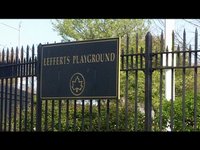
Lefferts-Playground
Place Category: Parks and Playgrounds
Lefferts Playground honors an influential Dutch family that resided in the Brooklyn neighborhood of Flatbush. The Lefferts traced their roots to Dutch colonist Pieter Janse Hagewout (1650-1704), a farmer and shoemaker who emigrated from Holland with his family aboard de Bonte Koe (The Spotted Cow) in 1660.
In 1776, 31,000 British soldiers invaded Long Island during the Revolutionary War. Several days before the Battle of Long Island (August 26-31, 1776), the Lefferts Homestead in Flatbush was destroyed, not by the British, but by American troops who burned several houses in an attempt to drive the British away. The Lefferts family left the area before this burning took place.
Peter Lefferts (1753–1791), the great-great-grandson of Pieter Hagewout, rebuilt the Lefferts Homestead between 1777 and 1783. Lefferts was one of the richest men in Kings County, with 240 acres of land and a large household that included eight family members and twelve slaves. He also enjoyed a wide sphere of influence, working in various public offices throughout New York. Lefferts served as a lieutenant in the Colonial Army and became a judge on the County Court of Sessions and Common Pleas. In 1788 he became a delegate to the state convention in Poughkeepsie, when New York ratified the United States Constitution. When Lefferts died on November 7, 1791, he was buried in the cemetery of the Reformed Protestant Dutch Church, where he had been a trustee.
Members of the Lefferts family continued to live in the house until 1918, when they donated it to the City. At that time the Lefferts Homestead was moved four blocks to its present location in Prospect Park, on Flatbush Avenue near Maple Street. It is administered by the Prospect Park Alliance, Parks, and the Historic House Trust of New York City who together preserve this important piece of New York City’s past.
This playground, bounded by North Conduit Avenue and 120th and 122nd Streets, is one of the Belt Parkway “ribbon parks” surrounding the highway in southwestern Queens. Arterial Coordinator and Parks Commissioner Robert Moses (1888-1981) planned the parkway along the routes of original Native American trails circling the perimeter of Brooklyn and Queens. He planned the adjoining parkland to compensate for green space lost during the construction of the thoroughfares.
A fence encircled this property as early as 1940, but plans for play equipment within the enclosure were not drawn up until over ten years later. The original 1951 plans for Lefferts Playground illustrate a comfort station, sand pit, wading pool, swings, slides, and an adjacent ball field/lawn area.
Council Member Juanita Watkins and Queens Borough President Claire Shulman each allocated $650,000 to fund a complete reconstruction of the park in 2001, creating a new playground area and transforming parts of the existing Moses playground into a peaceful resting place. The long, linear park presented a design challenge, with the solution found in the Art Nouveau style of design. The renovation project incorporated a curvilinear, decorative element which embodies the fluid lines found in nature. A water lily-shaped spray shower serves as the focal point to an inviting web of new additions, including benches, game tables, a reconstructed basketball court, and decorative street lamps. The old, sloping lawn was leveled, creating a rolling barrier to the adjacent highway, and transforming a little-used lawn into a neighborhood asset, with benches, a meandering path, and flowering and shade trees. The lawn was also mounded for the display of a large bronze crane. Undulating mounds and flowering beds surrounding the center space further enhance the unity of the park’s design.
- lefferts playground
Queens
New York
11420
United States No Records Found
Sorry, no records were found. Please adjust your search criteria and try again.
Google Map Not Loaded
Sorry, unable to load Google Maps API.
-

